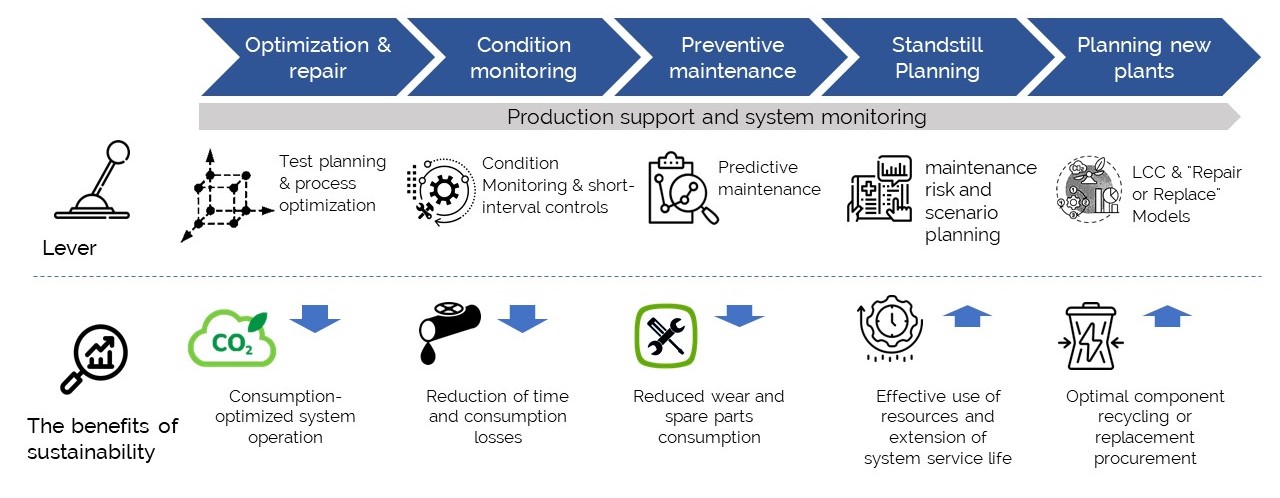
Optimizing industrial sustainability: Targeted use of value-oriented maintenance

Ecological Sustainability is Gaining Importance Across All Industrial Sectors
At the same time, the pressure to maximize cost-efficiency continues to grow. This creates a strategic conflict—especially for manufacturing companies—that will ultimately determine future business success. Those who manage to resolve this conflict can gain decisive competitive advantages. In this context, traditional activities in maintenance and asset management play a crucial role—both in daily operations and in the planning of new facilities.
At its core, industrial sustainability is about achieving an optimal balance between reducing resource consumption, minimizing environmental impact, and increasing productivity and economic performance. Effective maintenance and asset management methods provide transparency and enable the identification of appropriate actions to reach this balance.
Value-Oriented Maintenance makes a decisive contribution to reconciling economic efficiency and sustainability by optimizing and continuously managing equipment and systems. In predictive maintenance or during the planning of scheduled overhauls, this methodology further supports the identification and implementation of improvements that promote industrial sustainability. In the field of asset management, additional potential lies in the modernization of equipment and the planning of new installations—offering opportunities to enhance sustainability while simultaneously maximizing profitability.

1. optimization of plant operation and industrial sustainability by determining the optimum settings for the process parameters
The key areas of action mentioned are described in more detail below:
In many cases, only a few plants and processes have a major impact on the sustainability of a company's production. These are in particular consumption-intensive plants and processes and those that can have a strong positive influence on the sustainability balance of companies through improvements and modifications. These sustainability drivers and the effect of their specific process parameters can be identified and measured through targeted analyses. The results are incorporated into comprehensive modeling aimed at industrial sustainability. The target values defined in this way are then used for the continuous, systematic optimization of plant operation and the entire process and plant control system.
2. continuous system control ensures that industrial sustainability targets are met at all times
Continuous monitoring and control of production processes is crucial for many companies to ensure their long-term industrial sustainability. With knowledge of the optimum system operation and the critical process parameters and their target values, companies can use statistical process controls (SPC) and continuous monitoring of limit values to ensure that they operate within sustainable target and limit values. In the event of unplanned deviations, predefined corrective measures are initiated very promptly via defined short-interval controls. Depending on the type and scope, these corrective measures can either be carried out immediately by the system operator himself or involve obtaining further information or support via a qualified maintenance notification.
3. predictive maintenance makes it possible to anticipate and prevent problems before they occur
As a rule, most companies already record many parameters that are of great importance for sustainable operation, including malfunction data, downtimes and process data. However, additional data is required that can be recorded in the area of maintenance in order to optimize overall efficiency and industrial sustainability. Using critical components and their wear and function-critical parameters, the exact progression of wear can be modeled and these comprehensive wear models are used to record and evaluate the relevant information and derive measures to extend the service life of components.
This makes it possible to plan the optimum time for intervention so as not to lose production time or delay output. This approach also increases sustainability, as the energy resources used for production operations, for the execution of maintenance work and for the stocking of spare parts are used efficiently.
4. overall optimized maintenance planning extends the service life of the system and thus conserves resources
Environmental sustainability is becoming increasingly important in all sectors of industry. At the same time, the pressure to maximize profitability is increasing. For production companies in particular, this conflict of objectives is an issue that will determine the future success of the company. Those who resolve this conflict of objectives will gain decisive competitive advantages. In this context, traditional maintenance and asset management activities play an important role both in the operational process and in the design of new plants.
At its core, industrial sustainability is about finding the optimum balance between reducing resource consumption, minimizing environmental impact and increasing productivity and profitability as much as possible. Effective methods for maintenance and asset management create transparency and enable the identification of suitable measures to achieve the optimum.
Value-oriented maintenance makes a decisive contribution to reconciling profitability and sustainability in the optimization or continuous control of plants. In predictive maintenance or in the planning of inspection shutdowns, the methodology also supports the identification and realization of improvements in the area of industrial sustainability. In the area of asset management, there is also further potential to increase sustainability and maximize profitability at the same time when renewing and planning new plants (see figure below).
The key areas of action mentioned are described in more detail below:
Optimization of plant operation and industrial sustainability by determining the optimum settings for the process parameters
In many cases, only a few systems and processes have a major impact on the sustainability of a company's production. These are particularly consumption-intensive plants and processes and those that can have a strong positive impact on the sustainability balance of companies through improvements and modifications. These sustainability drivers and the effect of their specific process parameters can be identified and measured through targeted analyses. The results are incorporated into comprehensive modeling aimed at industrial sustainability. The target values defined in this way are then used for the continuous, systematic optimization of plant operation and the entire process and plant control system.
Continuous system control ensures that industrial sustainability targets are met at all times
Continuous monitoring and control of production processes is crucial for many companies to ensure their long-term industrial sustainability. With knowledge of the optimum system operation and the critical process parameters and their target values, companies can use statistical process controls (SPC) and continuous monitoring of limit values to ensure that they operate within sustainable target and limit values. In the event of unplanned deviations, predefined corrective measures are initiated very promptly via defined short-interval controls. Depending on the type and scope, these corrective measures can either be carried out immediately by the system operator himself or involve obtaining further information or support via a qualified maintenance notification.
Predictive maintenance makes it possible to predict and prevent problems before they occur
As a rule, most companies already record many parameters that are of great importance for sustainable operation, including malfunction data, downtimes and process data. However, additional data is required that can be recorded in the area of maintenance in order to optimize overall efficiency and industrial sustainability. Using critical components and their wear and function-critical parameters, the exact progression of wear can be modeled and these comprehensive wear models are used to record and evaluate the relevant information and derive measures to extend the service life of components. This makes it possible to plan the optimum time for intervention so as not to lose production time or delay output. This approach also increases sustainability, as the energy resources used for production operations, for the execution of maintenance work and for the stocking of spare parts are used efficiently.
Overall optimized maintenance planning extends the service life of the system and thus conserves resources
The planning and scheduling of major production shutdowns plays an important role in the profitability and sustainability of industrial production. Holistic scenario planning represents a decisive step towards efficient and effective maintenance and production planning. In particular, modeling and interpreting the technical condition of critical systems enables a more targeted prediction of unknown conditions and the associated risks and maintenance scenarios. As a result, various factors that are essential for sustainability can be optimally coordinated, such as:
- frequency and intervals of shutdowns,
- optimum duration and timing of shutdowns,
- sequences for shutdown and start-up of sub-systems,
- necessary system renewals or new systems,
- synergies or conflicts of products to be produced
Sustainability-optimized asset renewal and new asset planning for the entire asset portfolio
The management of the respective asset portfolio and upcoming asset replacements plays an essential role in maximizing the lifespan of industrial equipment and machinery, and thus also in industrial sustainability. When deciding whether to repair or replace aging assets, companies must consider a variety of factors, such as the overall condition of the assets and the costs associated with repair and replacement.
An asset condition assessment provides a meaningful result to determine the most economical and sustainable overall solution by choosing the right “repair or replace” options, and far-sighted planning of new assets is critical to their long-term success. This includes conducting life cycle cost (LCC) analyses to determine the total cost of ownership and the “Industrial Sustainability Index” over the life of the plant, as well as the use of predictive modeling. By simulating processes and analyzing data, the emissions of greenhouse gases, energy consumption or water requirements of a plant can be predicted, for example. This information can then be used to optimize processes and improve the sustainability of the plant.
Lasting progress through a combination of classic implementation methodology and value-oriented maintenance
Maintenance plays a crucial role in introducing technical improvements and enabling and utilizing new technologies. This applies in particular to the optimization of industrial sustainability. Maintenance also plays a key role in the procurement of data for all of the topics described above and provides additional support in the collection and qualification of the data required by the EU Corporate Sustainability Reporting Directive (CSRD).
The successful introduction and implementation of value-oriented maintenance in the field of industrial sustainability is achieved through good planning and goal orientation. The new processes and methods must be combined with existing process and plant knowledge, both as classic change and implementation expertise - only this will ensure lasting benefits.
Horn & Company supports you in describing the requirements for designing new processes and methods in maintenance and sustainability. Together with you, we develop the future-oriented use of value-oriented maintenance in sustainability and thus ensure that ecological and economic goals are harmonized in your company.
5. sustainability-optimized asset renewal and new asset planning for the entire asset portfolio
The management of the respective asset portfolio and upcoming asset replacements plays an essential role in maximizing the lifespan of industrial equipment and machinery, and thus also in industrial sustainability. When deciding whether to repair or replace aging assets, companies must consider a variety of factors, such as the overall condition of the assets and the costs associated with repair and replacement. An asset condition assessment provides a meaningful result to determine the most economical and sustainable overall solution by choosing the right “repair or replace” options, and far-sighted planning of new assets is critical to their long-term success. This includes conducting life cycle cost (LCC) analyses to determine the total cost of ownership and the “Industrial Sustainability Index” over the life of the plant, as well as the use of predictive modeling. By simulating processes and analyzing data, the emissions of greenhouse gases, energy consumption or water requirements of a plant can be predicted, for example. This information can then be used to optimize processes and improve the sustainability of the plant.
Lasting progress through a combination of classic implementation methodology and value-oriented maintenance
Maintenance plays a crucial role in introducing technical improvements and enabling and utilizing new technologies. This applies in particular to the optimization of industrial sustainability. Maintenance also plays a key role in data procurement for all the topics described above and also provides support in collecting and qualifying the data required by the EU Corporate Sustainability Reporting Directive (CSRD).
The successful introduction and implementation of value-based maintenance in the area of industrial sustainability requires good planning and goal orientation. The new processes and methods must be combined with existing process and plant knowledge, both as classic change and implementation expertise - this is the only way to ensure lasting benefits.
We support you in describing the requirements for designing new processes and methods in maintenance and sustainability. Together with you, we develop the future-oriented use of value-oriented maintenance in sustainability and thus ensure that ecological and economic goals are harmonized in your company.


